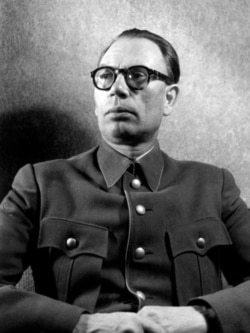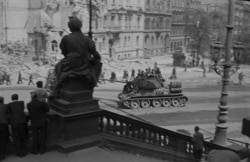It was bad enough that a local mayor in Prague wanted to take down a statue dedicated to the Red Army commander who helped push Nazi forces out of the Czech capital in the final days of World War II.
Now, adding insult to injury, a mayor in another Prague district wants to put up a statue dedicated to a ragtag force that some Czechs say did more to retake Prague than the Soviet Army did -- a force led by Andrei Vlasov, a man some Russian historians say was a Nazi sympathizer.
It's the latest example, from around the former Warsaw Pact nations of Central and Eastern Europe, of countries staking a claim to postwar history that doesn't align with the version of history Moscow hews to.
So who exactly was Vlasov and what was his Russian Liberation Army, also known as the Vlasovites?
Strategist Extraordinaire?
Born in 1901 in what was then imperial Russia, Andrei Vlasov was drafted into the Red Army in 1919 and fought in the Russian Civil War.
He joined the Soviet Communist Party in 1930 and traveled to China in 1938 to serve as a military adviser to Chiang Kai-shek, the Chinese nationalist leader who battled Chinese communists and ultimately lost.
Vlasov was a top military tactician, who confirmed it on the battlefield, those who studied his background say. Early in the war with Nazi Germany in 1941, Vlasov saved an army from encirclement outside Kyiv, according to military historians.
For that, Vlasov was invited to Moscow in November, where he met Soviet dictator Josef Stalin, who later tasked him with helping General Georgy Zhukov defend Moscow from invading German forces.
In the spring of 1942, Vlasov was entrusted with command of the Soviet 2nd Shock Army, personally ordered by Stalin to try to fight through German lines to lift the siege of Leningrad, according to historians.
After Vlasov was captured in July 1942, Nazi officers proposed that he switch sides, offering him the chance to form a battalion. He agreed. Those he recruited among the thousands of prisoners of war (POWs) captured by the Nazis were given the choice: join or starve.
According to historian Christopher Simpson, the overwhelming majority of Soviet prisoners of war refused. "Two million POWs who were given the choice of collaboration or starvation between 1942 and 1945 chose death before they would aid the Nazis," Simpson wrote in his 2014 book Blowback: America’s Recruitment Of Nazis And Its Destructive Impact On Our Domestic And Foreign Policy.
Vlasov apparently believed Adolf Hitler would allow him not only to raise a force, as well as equip and arm it, but allow them to fight. He was "convinced that it was possible to overthrow Stalin and establish another form of government in Russia," Simpson wrote, quoting a 1949 magazine story that promoted American efforts to recruit Vlasov's veterans.
Regardless of his motivations, "Vlasov's organization consisted in large part of reassigned veterans from some of the most depraved SS and 'security' units of the Nazis' entire killing machine," according to Simpson.
WATCH: Latest Historical Dispute In Prague Inflames Czechs And Russians
The Nazis weren't sure what to do with this ragtag unit known as the ROA, according to multiple historians.
On the one hand, Hitler encouraged Vlasov's anti-Bolshevik efforts to sow discord inside the Soviet Army. Vlasov's most notable effort was a leaflet that was airdropped over Soviet-controlled territory in 1943.
On the other hand, Hitler, who considered Slavs to be subhuman, refused to work with a force made up of men the German dictator considered "untermenschen."
Vlasov’s army -- which numbered tens of thousands of soldiers at its height --fought Soviet forces only once in February 1945, around the Oder River east of Berlin. After three days of brutal combat, the outnumbered and out-battled Vlasov units retreated, heading south toward Prague in German-occupied Bohemia.
Vlasov Army Flips Sides
On May 5, as Czech resistance forces staged an uprising against Nazi occupying forces in Prague, Vlasov's units were camped approximately 40 kilometers from the city, according to Kirill Aleksandrov, a Russian historian who has written extensively about Vlasov.
A day later, ROA units were in Prague, but not Vlasov. He remained behind; conflicting historical accounts say he was either sick with a fever or on a drinking binge.
Sergei Bunyachenko, a top ROA officer leading the units in Prague, asked Vlasov to allow the ROA fighters to join the Czech resistance fighters in the city. Vlasov eventually consented, for reasons that have never been made clear.
Some historians say it may have been resentment over how ROA fighters were treated by the Nazis that prompted the switch. Others say the ROA fighters, hoping to reach the West, hoped to score public-relations points by aiding the Czech resistance.
In a 2015 interview with Radio Prague International, Aleksandrov said Czech resistance fighters in Prague were armed only with simple weapons, like hunting rifles, while the Germans had tanks and artillery. The Vlasov units also had artillery and tanks, he said; without the Vlasovites there probably wouldn't have been an uprising.
"It's absolutely clear that without the Vlasov army fighters the Prague [fighters] would have suffered colossal human losses," Aleksandrov said. "The number of victims was still high, some 1,500 victims, but it could have been worse, much worse."
After the fighting ceased, Vlasov was among a group of ROA fighters to fall into the hands of U.S. soldiers. As fate had it, the Americans later handed him and other ROA members over to the Soviets in a prisoner exchange.
Vlasov and other ROA leaders were executed in Moscow in August 1946 after a closed-door trial.
Beating The Red Army To Prague
On May 8, when an official "capitulation protocol" between the Czech National Council and the Nazi leadership entered into force, Vlasovites were in Prague. Absent were Red Army units which entered the Czech capital a day later.
"The Red Army appear in Prague only once the war had ended," Aleksandrov stated in the 2015 interview. "De jure and de facto."
That chronology conflicts with the long-standing Soviet, and Russian, narrative of the Soviet victory over Nazi Germany.
"The question of the Vlasovites suggests the whole Russian myth is based on a lie," Jan Sir, a professor in the Russian and Eastern European department of Prague's Charles University, told the Czech news site Lidovky.cz.
Aleksandrov faced harsh criticism in 2016 over his doctoral thesis on Vlasov. War veterans and some academics have called for his prosecution under a Russian law forbidding the propagation of "wars of aggression."
One Russia history professor who also served in the war said in 2016 that Aleksandrov's thesis "destroys the memory of Russia's greatest victory."
Whose History?
The competing history of the Vlasov army is not the only chapter of World War II that Russia has taken issue with.
Earlier this year, some Russian historians, as well as the Foreign Ministry, defended the Molotov-Ribbentrop Pact, which effectively gave Hitler a free hand to attack Poland without fear of Soviet intervention.
Years later, historians discovered that the pact included a secret protocol that Hitler and Stalin had agreed on, dividing Central and Eastern Europe into spheres of influence.
Russian and Western experts argue that glorifying elements of the Soviet history and blurring Stalin's brutal legacy have become a political tool for Russian President Vladimir Putin.
The proposal for the Vlasov memorial, in a southwest district of Prague, is to be discussed by the local council on December 16.
The argument is not the first time this year that Czechs and Russians have clashed over a historical monument.
Czech officials in 2018 erected a plaque on a 38-year-old statue dedicated to Marshal Ivan Konev, another Red Army commander who helped defeat Nazi forces in Czechoslovakia. The plaque explained that Konev was involved in suppressing the Hungarian uprising in 1956 and had a role in the Warsaw Pact invasion of Czechoslovakia in 1968 that crushed the pro-democracy Prague Spring. The plaque also infuriated Moscow, which argued that it maligned Konev's role.
The Konev statue, located in a northwestern district of Prague, was vandalized with paint and graffiti earlier this year, and some Czech officials have now called for it to be moved entirely, to an out-of-the-way corner of the city, a proposal that has further enraged Moscow.
"They [the Russians] think they liberated us from the Nazis in 1945 and 1968," Sir told Lidovky.cz. "There's simply no other way to justify any of this than with a lie."















